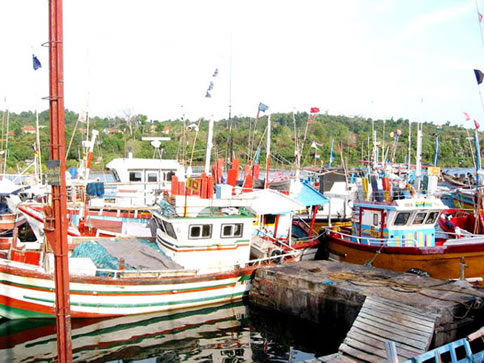Ilankai Tamil Sangam30th Year on the Web Association of Tamils of Sri Lanka in the USA |
||||
 Home Home Archives Archives |
Sri Lanka’s Fishy Storyby Tamil Guardian, London, November 29, 2010
After 32 consecutive years of losses, Sri Lanka's state-owned Fisheries Corporation announced this July it had made a profit. The explanation, inevitably, was ‘the end of the war’. But a close look suggests much more than that: a militarized and ethnicised monopoly in the making. For the past two decades, much of the island’s Northeastern waters were subject to government fishing restrictions violently enforced by the navy. The explanation was, of course, the threat posed by the LTTE’s naval wing. However, the Sea Tigers were first formed only in 1991 and grew only gradually to be able to challenge Sri Lanka’s navy – and then largely off the northern coasts. In any case, there have been no restrictions on fishing off the large Sinhala-dominated coast to the south and west. (Moreover, the Eastern province was declared ‘liberated’ by the government in early 2007.) Sinhala Only The real impact of Sri Lanka’s military-enforced restrictions has been to devastate and impoverish the Tamil fishing communities along the northeastern coasts – Sinhala fishermen, however, were able to fish at will in many ‘restricted’ areas, under the protection of naval gunboats. Moreover, during the armed conflict, Tamil fishing boats and coastal fishing villages were subject to repeated Sri Lankan naval and aerial bombardment, driving the inhabitants inland, and away from their livlihoods. Since the defeat of the LTTE in May 2009, Sinhala fishermen have also been fishing untrammeled in the northern waters, while Tamil fishermen there continue to endure restrictions, as well as ad hoc taxes - such as summary seizures of their catches by the local military. At the same time, the military is protecting the Sinhala fishermen’s monopoly by attacking fishing boats of their competitors from neighboring Tamil Nadu. The practice began long ago alongside the harassment of Tamil fishermen in the Northeast. The resultant deaths and injuries have repeatedly been a source of diplomatic friction between Sri Lanka and India, featuring again in Indian foreign minister S. M. Krishna’s visit last week (see point 20 in the 7th joint commission’s statement). Indeed, though it is rarely highlighted, there are just as many Sinhala incursions into Indian waters (in search of tuna) as there are Tamil Nadu incursions (in search of shrimp) into Sri Lankan waters, a practice - in theory a 'common understanding' by both countries (see page 10 and Appendix V of this study). However, these boats are owned by commercial interests and are seldom owned by fishermen. (Also, see V.Vivekanandan's conference paper on 'Crossing maritime borders' here). In short, Sri Lanka's occasional and much-publicized handing over of fishing equipment to Tamil fishing communities is intended to distract from the structural undermining of the Tamil fishing industry, and thereby preventing its revival.
Monopoly transfer Meanwhile, the high price of fish in Sri Lanka has to do with government policy: fish is taxed at 40 percent. Even canned fish is heavily taxed. Moreover, the real driver behind the state-owned corporation’s new profitability is something else: its taking over from the ‘middle-men’ who buy fishermen’s catches and sell for a profit to retailers. Fisheries and Aquatic Resources Development Minister Rajitha Senaratne this week vowed to put an end to this ‘control’ of the fish market by ‘intermediaries’. “The intermediaries buy one kilogram of fish at Rs 100, but by the time it reaches the hands of the consumers, the price has increased to Rs 500,” he said. “Neither fishermen nor consumers benefit from this," he claimed. "We will not let this happen for too long.” Apparently, the state would be better placed to distribute the catches taken off fishermen – whom, the minister said, wouldn’t see any difference: “reduced fish prices are not going to affect fishermen.” In anticipation of its strengthened monopoly, the State Corporation is planning to open 250 outlets across the country, from 64 at present. Markets – with a twist And if the fishermen were not amenable to cheaper prices, Sri Lanka is working on another solution. “We will bring fish prices down by way of establishing our capacity with fish resources with the Fisheries Corporation,” Dr. Senaratne said. In other words, the state-owned corporation’s own boats will be going to sea. “The corporation is waiting to get a fleet of over 1,000 multi-day fishing vessels in keeping with an Agreement signed between the Fisheries Ministry and two foreign business companies.” The fishermen need not worry, because he promises to look after them: “every fishing family will get insurance, a pension, scholarships for their children and houses under a Welfare scheme the ministry would introduce”. Not that the state has abandoned market principles – when it comes to foreign consumers that is: the Ministry of Fisheries has decided to grant state licenses for Saudi Arabia to fish in Sri Lankan waters (see also here). 400 Saudi boats are to arrive soon to engage in deep sea fishing. Saudi Arabia has agreed to pay 20% of the harvest to the Sri Lankan state as royalty: half free, half at one dollar a kilo. |
|||
|
||||

